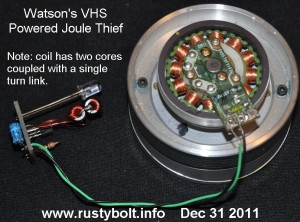 Not all of my many Joule Thiefs are powered by electrochemical means. Some are powered by electromechanical devices. This one is powered by the rotating head assembly of a VHS tape recorder. As can be seen, the motor is a series of coils wound around an armature inside of the rotating magnet, which is attached to the rotating heads. The assembly has enough mass so that a good spin with the fingers produces a bright light for about a second or two.
Not all of my many Joule Thiefs are powered by electrochemical means. Some are powered by electromechanical devices. This one is powered by the rotating head assembly of a VHS tape recorder. As can be seen, the motor is a series of coils wound around an armature inside of the rotating magnet, which is attached to the rotating heads. The assembly has enough mass so that a good spin with the fingers produces a bright light for about a second or two.
This motor reminds me of the motors I’ve seen in 5-1/4 inch floppy drives. They have a similar armature that has wire wound around the legs, and the wire can be removed to make coils for JTs. This motor has just a few connections so it was easy to check them for continuity and then hook up the JT and see if it lit up when spun. The windings of other motors may be connected differently than this one, but I have not seen any other VHS recorders. All I know is that these are different than the windings of a hard disk drive,which seems to be typical of most brushless DC motors.
This Joule Thief was one where I experimented with the coil. I used very small toroid cores, and I put the feedback winding on a separate core and coupled the two cores together with a single turn link of heavy wire. This works just fine. The two cores are electrically the same as one core. This is the only JT core to which I’ve done this, probably because I haven’t though of any reason why it would be of benefit. But it does work okay.
I have built dozens of these electromechanically driven JTs, some with motors from hard disk drives, some with motors from floppy disk drives, and some with motors from CD-ROM drives. Oh, yeah, I forgot about those motors I scrounged out of old inkjet printers. They all generate low voltage, which the JT boosts and lights up the LED brightly. Some motors don’t need the Joule Thief, they are capable of generating enough voltage to drive the LED directly. The CD drives are fun because the motors are small and often come with a gear mechanism which can spin the motor fast enough to generate decent light. Problem is that most of these motors have to be spun by hand, and it can get really boring really quick, especially when the shaft starts to cause your fingers to feel like they are going to be worn out. In the case of this VHS motor, it’s really easy to spin and does a good job.
Back to experimenting.











